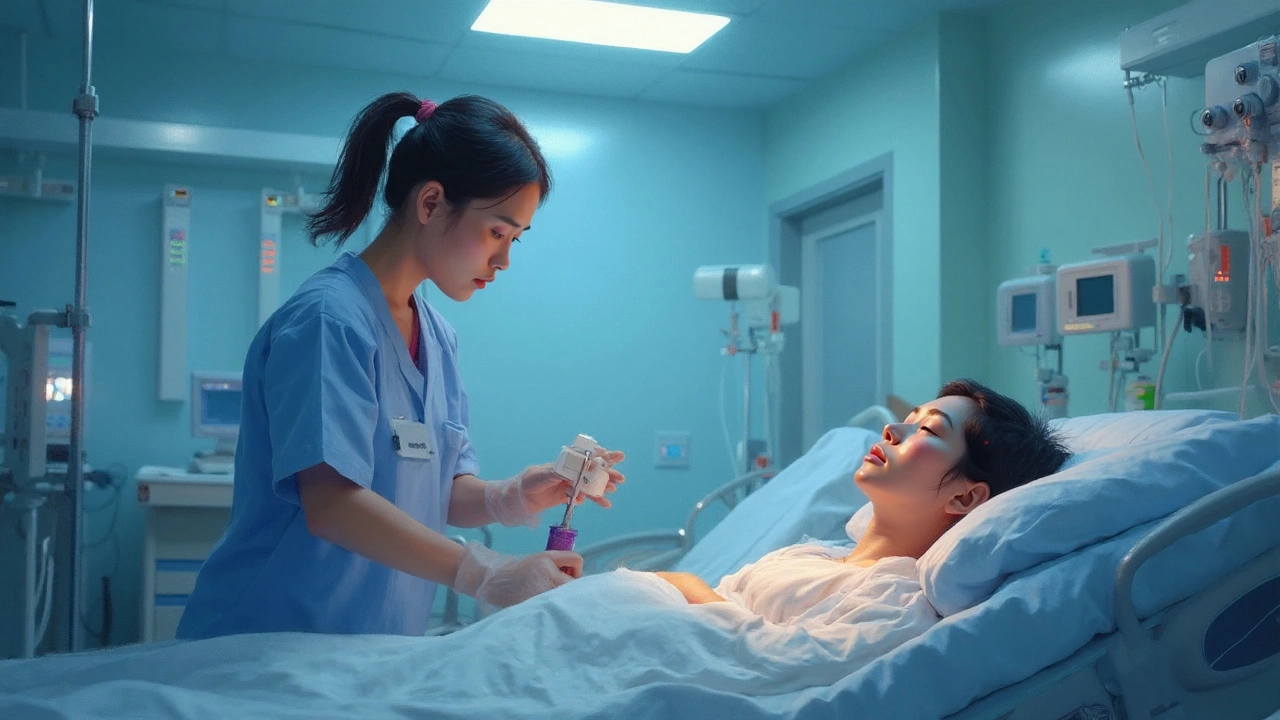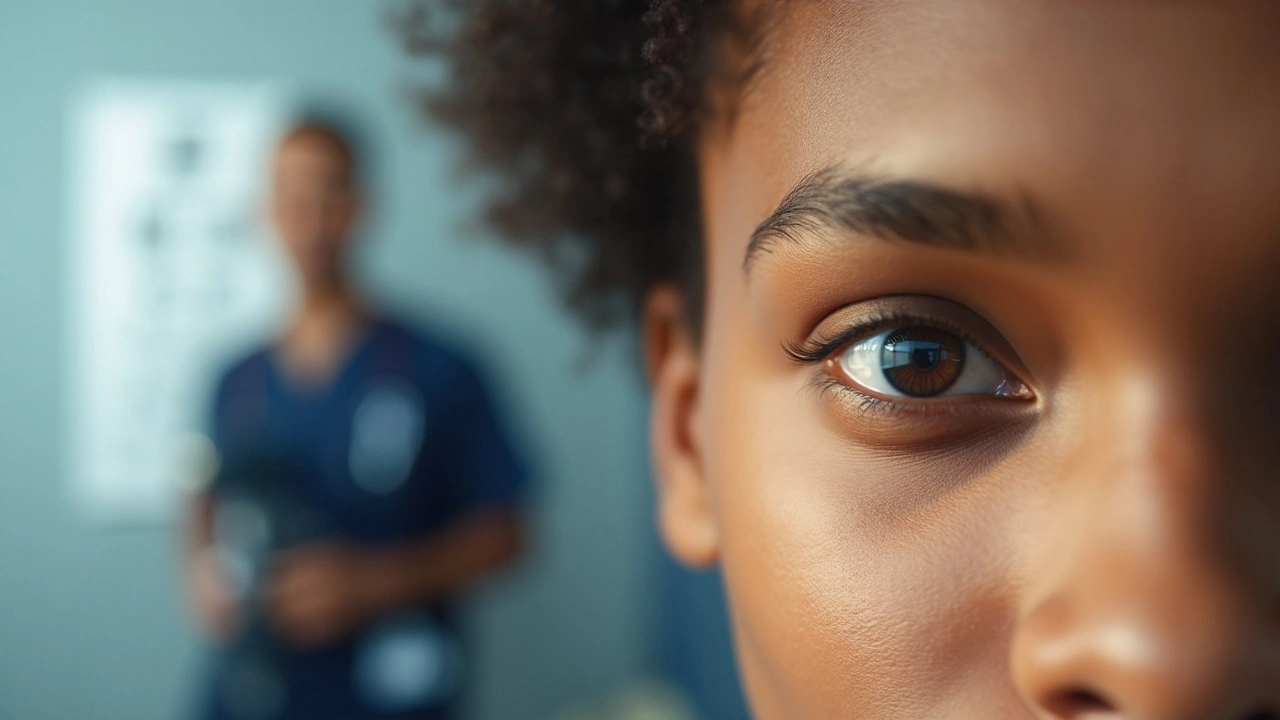Myosis is a physiological response where the pupil constricts, reducing the aperture of the iris sphincter muscle. This narrowing can be intentional-like when a doctor prescribes a miotic-or a side effect of systemic or topical agents.
TL;DR
- Myosis means pupil constriction; it can be therapeutic or adverse.
- Common miotic drugs include Pilocarpine and Carbachol.
- Opioids and Alpha‑2 agonists (e.g., clonidine) also trigger myosis.
- Use miotics for glaucoma, ocular pressure control, or postoperative care, but watch for side effects like bright‑light intolerance.
- Always check drug interactions with the Parasympathetic nervous system and existing eye conditions.
How the Pupil Works: A Quick Anatomy Refresher
The pupil is an opening in the Iris that regulates retinal light exposure. Two muscles control its size: the sphincter (parasympathetic‑driven) narrows the pupil, while the dilator (sympathetic‑driven) widens it. The balance between the Parasympathetic nervous system and the Sympathetic nervous system determines steady‑state pupil diameter.
When a drug stimulates muscarinic receptors on the sphincter, the iris contracts and myosis occurs. Conversely, blocking these receptors or activating alpha‑adrenergic receptors leads to dilation (mydriasis). Understanding which pathway a medication targets helps predict ocular effects.
Medications That Induce Myosis
Several drug classes deliberately or inadvertently cause pupil constriction. Below is a concise rundown of the most relevant agents.
- Pilocarpine: a direct cholinergic agonist frequently prescribed for open‑angle glaucoma. Typical topical dose is 1-2% eye drops, 1-2 drops every 4-6hours.
- Carbachol: another cholinergic agonist used post‑cataract surgery to prevent posterior synechiae. Concentrations range from 0.025% to 0.05%.
- Opioids (e.g., morphine, fentanyl): systemic analgesics that activate central mu‑receptors, indirectly enhancing parasympathetic outflow and causing pinpoint pupils.
- Alpha‑2 agonists (clonidine, apraclonidine): reduce sympathetic tone, shifting the balance toward parasympathetic dominance and producing mild myosis.
- Topical antihistamines with anticholinergic properties can occasionally cause partial constriction when combined with other miotics.
Therapeutic Uses of Myotic Drugs
While myosis is often an unwanted side effect, clinicians harness it for several eye conditions:
- Glaucoma: Lowering intraocular pressure (IOP) by opening the trabecular meshwork; pilocarpine remains a first‑line agent in many low‑resource settings.
- Pre‑operative preparation for intraocular surgery: Achieving a small pupil helps surgeons control intra‑ocular fluid dynamics.
- Management of uveitis: Constricting the pupil reduces inflammation spill‑over to the anterior chamber.
- Diagnostic testing: Inducing myosis can reveal early lens opacities that are hidden with a dilated pupil.

Risks, Contra‑indications, and Side‑Effects
Miotic therapy isn’t risk‑free. Common concerns include:
- Photophobia - bright light becomes uncomfortable because less light reaches the retina.
- Blurred near vision - excessive constriction can affect accommodation.
- Rebound hyperemia - prolonged use of pilocarpine may cause vascular congestion.
- Systemic absorption - especially with high‑frequency dosing, leading to bradycardia or bronchospasm in susceptible patients.
Contra‑indications typically involve pre‑existing retinal detachment, severe angle‑closure glaucoma, or known hypersensitivity to cholinergic agents.
Interaction Landscape: What Happens When Drugs Mix?
Because pupil size is governed by a tug‑of‑war between two autonomic branches, many drug interactions pivot on that balance.
- Miotics + Mydriatics (e.g., tropicamide): Concurrent use can produce unpredictable pupillary responses and may worsen ocular pressure. \n
- Opioids + Anticholinergics (e.g., scopolamine): Anticholinergics can blunt opioid‑induced pinpoint pupils, masking overdose signs.
- Alpha‑2 agonists + Sympathomimetics (e.g., phenylephrine): The former reduces sympathetic tone; the latter attempts to restore it, potentially causing erratic fluctuations.
When prescribing, always review a patient’s full medication list, especially systemic agents that influence autonomic tone.
Practical Checklist for Clinicians and Patients
- Confirm indication: glaucoma, uveitis, post‑operative care, or diagnostic need.
- Choose the appropriate miotic: pilocarpine for chronic IOP control, carbachol for short‑term post‑surgical effect.
- Verify dosage and frequency: avoid exceeding recommended drops to limit systemic absorption.
- Screen for contraindications: angle‑closure risk, respiratory disease, cardiac arrhythmias.
- Educate patients on side‑effects: photophobia, transient blurred vision, possible sweating.
- Schedule follow‑up: assess IOP, pupil size, and visual acuity within 1-2 weeks of initiation.
Related Concepts and Next Steps
Understanding myosis opens doors to broader ophthalmic topics. You might explore:
- Mydriasis - the opposite reaction and its clinical relevance.
- Pharmacokinetics of ocular drugs - how tear turnover, corneal permeability, and systemic circulation affect dosing.
- Advances in drug‑delivery systems - sustained‑release implants that minimize dosing frequency.
Each of these areas deepens the picture of how medications shape visual function.
| Drug | Mechanism | Typical Concentration | Primary Use | Key Side‑Effects |
|---|---|---|---|---|
| Pilocarpine | Muscarinic agonist (M3) | 1-2% eye drops | Open‑angle glaucoma control | Photophobia, brow ache, flushing |
| Carbachol | Non‑selective cholinergic agonist | 0.025-0.05% eye drops | Post‑cataract surgery | Transient blurred vision, ciliary spasm |
| Apraclonidine | Alpha‑2 adrenergic agonist (reduces sympathetic tone) | 0.5% eye drops | Adjunct for acute angle‑closure glaucoma | Dry mouth, mild myosis |
| Opioids (systemic) | Mu‑receptor activation → parasympathetic dominance | Varies (e.g., morphine 2‑10mg IV) | Analgesia - side‑effect of pinpoint pupils | Respiratory depression, constipation |

Frequently Asked Questions
Why does my doctor prescribe eye drops that make my pupils smaller?
Miotic eye drops like pilocarpine increase the outflow of aqueous humor, lowering intra‑ocular pressure. This is essential for controlling glaucoma and preventing optic nerve damage.
Can systemic medications cause myosis?
Yes. Opioids, certain antihypertensives, and alpha‑2 agonists can trigger pupillary constriction as a side‑effect by shifting autonomic balance toward parasympathetic activity.
Is myosis ever dangerous?
Acute, severe constriction can limit retinal illumination, worsening night vision and causing discomfort. In rare cases, excessive miotic use may precipitate angle‑closure attacks in predisposed eyes.
How long does drug‑induced myosis last?
Topical miotics usually act for 4-6hours, while systemic agents like opioids can keep pupils pinpointed for the duration of the drug’s half‑life (often 2-4hours for morphine). Discontinuation leads to gradual return of normal size.
What should I do if my pupils stay constricted after using eye drops?
Contact your eye care provider promptly. Prolonged myosis may indicate overdose, drug interaction, or an underlying ocular condition requiring adjustment of therapy.
Can I wear sunglasses to relieve photophobia from miotics?
Yes, tinted lenses are the simplest way to reduce glare and improve comfort while the medication is active.
Are there alternatives to miotic drugs for glaucoma?
Modern first‑line options include prostaglandin analogues (latanoprost, bimatoprost) and beta‑blockers (timolol). Miotics are reserved for specific cases or when other agents are contraindicated.


Donnella Creppel
September 21, 2025 AT 20:56Oh, dear readers, you *think* you’ve grasped miotics? Let me enlighten you-these drops are not just for hippie ophthalmologists, they’re a symphony of cholinergic fireworks, darling!!! And don’t even start on the photophobia-it's like staring into a neon apocalypse!
Jarod Wooden
September 21, 2025 AT 22:20One must confront the ontological asymmetry inherent in pharmacodynamic discourse; the myopic reduction of pupil diameter is merely a phenomenological manifestation of parasympathetic hegemony, and your superficial overview betrays a lack of epistemic rigor-step up your game.
lee charlie
September 22, 2025 AT 00:00The guide does a solid job of laying out the basics of miotic pharmacology. It starts by defining myosis in clear terms. It then explains the two main muscles that control pupil size. The description of how cholinergic agents act on the sphincter muscle is useful. The list of common drugs like pilocarpine and carbachol is straightforward. The therapeutic uses for glaucoma and post‑operative care are well explained. The side‑effects section reminds us about photophobia and blurred near vision. The interaction notes about miotics versus mydriatics are a nice safety reminder. Overall the article balances anatomy, pharmacology, and clinical pearls. It feels like a quick reference you could keep on a desk. The checklist at the end is practical for clinicians. The FAQs anticipate common patient concerns. Even the table summarizing drugs is handy. In short, it’s a concise yet comprehensive primer on myotic therapy.
Greg DiMedio
September 22, 2025 AT 01:40Wow, a real deep dive-said no one while skimming the bullet points. Guess we’ll all need a PhD to understand that “tug‑of‑war” metaphor.
Badal Patel
September 22, 2025 AT 03:20Esteemed colleagues, indulge me as I present a most theatrical exposition upon the subject of ocular constriction-indeed, the very act of miotic administration doth unfold as a ballet of chemical choreography! Yet, despite such grandeur, one must not overlook the pernicious shadows cast by over‑zealous dosing; a veritable tempest of photophobia may besiege the humble patient! Moreover, allow me to interject, albeit with a flourish of punctuation, that the interplay between opioids and anticholinergics resembles a discordant duet-notes clashing in a cacophony of clinical misdirection?
KIRAN nadarla
September 22, 2025 AT 05:00Analysis: The author correctly identifies pilocarpine’s mechanism, but neglects to mention its half‑life variability across corneal permeability. Grammar note: "myosis" should be capitalized only if starting a sentence. Additionally, the table omits dosage frequency for apraclonidine-an oversight that could mislead prescribers. Clinically, the risk of rebound hyperemia is understated; literature cites a 12‑% incidence in chronic users. Recommendation: include a monitoring protocol for IOP fluctuations post‑initiation.
Kara Guilbert
September 22, 2025 AT 06:40Honestly, it baffles me how some people think these miotic drops are just harmless eye drops-they’re not! Using them without proper screening is downright irresponsible and shows a lack of moral compass. If you prescribe pilocarpine to a patient with undiagnosed angle‑closure risk, you’re essentially inviting disaster. The guide should have shouted louder about contraindications, not whispered them. People need to understand that bright‑light intolerance isn’t just an inconvenience; it’s a sign of deeper trouble. So, let’s hold ourselves accountable and demand stricter guidelines.
Sonia Michelle
September 22, 2025 AT 08:20What a thoughtful synthesis of pharmacology and patient care! Your emphasis on patient education, especially regarding photophobia, resonates deeply. By framing the checklist as a collaborative tool, you empower both clinicians and patients. The balanced view of miotics versus modern prostaglandin analogues offers practical decision‑making guidance. Thank you for weaving scientific rigor with compassionate outreach.
Neil Collette
September 22, 2025 AT 10:00Let me break it down for the masses: miotics are the unsung heroes that keep your eye pressure in check, yet everyone pretends they’re obsolete because they love new‑fangled jargon. In reality, pilocarpine still outperforms many “advanced” drops in low‑resource settings-news flash! If you ignore the humble cholinergic agents, you’re basically saying the cheap solution is worthless, which is as absurd as claiming a bicycle can’t win a race against a car on a flat road.
James Lee
September 22, 2025 AT 11:40Great summary.
Dennis Scholing
September 22, 2025 AT 13:20Colleagues, let us consider the paramount importance of comprehensive patient counseling when initiating miotic therapy. It is advisable to outline the expected timeline of pupil constriction, potential visual disturbances, and the necessity of follow‑up appointments within one to two weeks. This structured approach not only fosters adherence but also mitigates adverse outcomes.
Kasey Lauren
September 22, 2025 AT 15:00Nice work! The guide is super helpful and the tips on sunglasses are spot on. Keep it up!
joshua Dangerfield
September 22, 2025 AT 16:40I’m curious about how systemic absorption varies with dosing frequency-any data on plasma levels after high‑frequency pilocarpine use? Also, could you expand on the role of carbachol in post‑operative care beyond just preventing synechiae? These details would really round out the guide for clinicians who manage complex cases.
Abhimanyu Singh Rathore
September 22, 2025 AT 18:20Attention to detail, dear author! However, note that the phrase “muscarinic agonist (M3)” should be capitalized as “Muscarinic” when referring to a class, and the semicolon after “Alpha‑2 agonists (clonidine)” is unnecessary-replace with a comma. Moreover, the table header lacks proper alignment; consider using for clarity. Your content is solid, but precision in presentation enhances credibility.-

-

- About
- Terms
- Data Protection
- Contact
- Privacy Policy
Stephen Lewis
September 22, 2025 AT 20:00It is commendable that the article systematically addresses both therapeutic benefits and potential hazards of miotic agents. By integrating a practical checklist, the author facilitates evidence‑based decision‑making. I would recommend adding a flowchart to visualize the decision pathway for clinicians, thereby further strengthening the educational value.
janvi patel
September 22, 2025 AT 21:40Honestly, I think the whole miotic hype is overrated.
Write a comment
© 2025. All rights reserved.